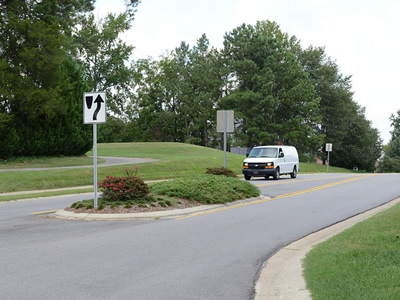City Councilors are considering a change that would include public input earlier in the planning process for traffic calming.
Members of the Law and Public Safety Committee Tuesday reviewed and approved changes to the traffic calming petition process.
Today, when a citizen requests traffic calming devices, transportation staff study the street to see if it meets the requirements needed to be added to a list of major and minor projects. If the street meets the program requirements, a petition is circulated and must be signed by 75 percent of the residents on that street before the process can move forward.

Photo by City of Raleigh
A van drives thorugh an area with traffic-calming mechanisms in place.
Transportation staff then meet with the neighborhood before creating a design of which traffic calming measures will be used and where they will be located.
Then, a second neighborhood meeting and a City Council public hearing take place.
But Tuesday the Council committee approved a new process in which the informational meeting will occur before the petition process. If the process change is approved, planners will design a plan after the petitions garner 75 percent support.
Transportation Planning Manager Eric Lamb said this way, residents will have a better idea about the types of traffic calming devices used for their particular street.
A resident who lives near a recent traffic calming project on Rainwater Road said it’s unlikely that many people will come to the informational meeting before there are designs for the road.
The Rainwater Road project sharply divided the neighborhood and required City Councilors to produce a compromise.
“At some point you need something like a kill switch,” said the resident, adding that if the neighbors don’t like what is being offered, the city should pack up and go away.
Councilor John Odom said the council is effectively the kill switch for a project, because it is up Councilors to approve or deny a project.
The full Council will vote on the process change at its next regular meeting.
Residents Could Crowdsource City Projects
Residents could have the opportunity to pay for unfunded city projects if a Kickstarter-like program is approved.
The crowdfunding option was initially heard in the Technology and Communications Committee, but was discussed in Tuesday’s Law and Public Safety Committee to address lingering concerns about maintenance and equality.
Under the original proposal, Councilors expressed concern that wealthier neighborhoods would be able to pay for more projects than communities with higher poverty rates.
Assistant City Manager Daniel Howe said if this process were implemented, staff would create a list of unfunded projects that would be eligible for crowdsourcing. For example, residents wouldn’t be allowed to fundraise for one bike rack just for their neighborhood, but would have to fundraise for multiple racks that would be scattered throughout the city.
Each project cost would include an additional 1.25 percent to account for future maintenance.
The projects would have to be up to city standards and follow a certain level of conformity to minimize possible problems down the line. In other words, all the bike racks would be the standard upside down U rack.
Projects that don’t quite fit into this requirement, such as public art, would be looked at on a case-by-case basis.
Howe said staff will have to find a good project scale so that it’s worth the time and effort for the city to construct and maintain a project, but not so big that it takes away from other priorities.
For example, crowdfunding a paper towel dispenser in a public bathroom would be too small, but regional transit would be too big.
City staff will report back to the committee with more information on what third-party website will be used to host the crowdfunding and what projects would be eligible.
